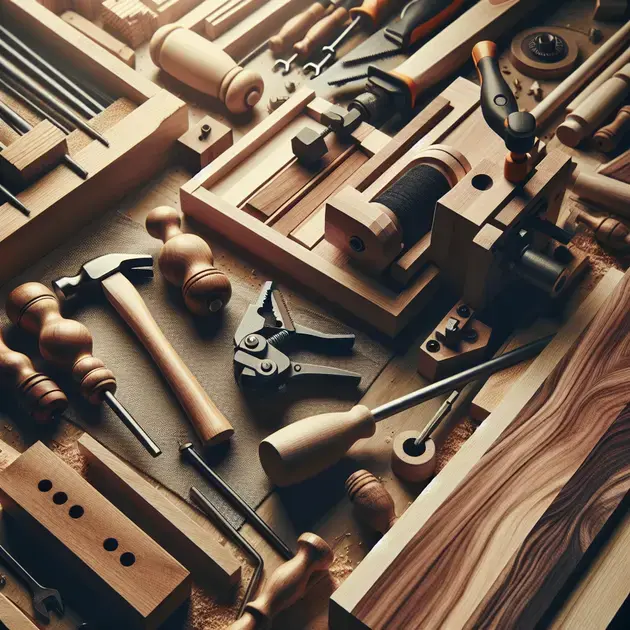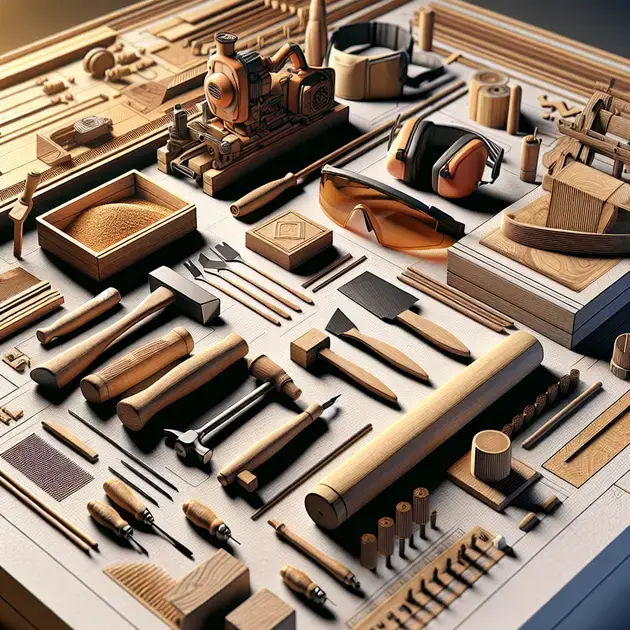Are you new to the world of woodwork and feeling overwhelmed by the plethora of tools available? Look no further, as this beginner’s guide will walk you through the essential tools for woodwork. Whether you’re embarking on DIY projects or pursuing woodworking as a hobby, having the right tools is crucial for a successful outcome.
Woodworking has evolved over the years, and so have the tools used in this craft. In this comprehensive guide, we’ll explore the must-have tools that every aspiring woodworker should have in their workshop. From measuring and cutting to shaping and finishing, these essential tools will set you on the right path to honing your woodworking skills.

Getting Started with Essential Woodworking Tools
Woodworking is a rewarding hobby that allows you to create beautiful and functional pieces of furniture and decor. However, getting started can be overwhelming with the plethora of tools available. To begin your woodworking journey, it’s essential to have a basic set of tools. The website Wood Magazine provides detailed reviews and recommendations for essential woodworking tools.
1. Start with the Basics
Begin by investing in a quality hammer, tape measure, carpenter’s square, and handsaw. These tools are fundamental for accurate measuring, cutting, and assembly of wood pieces.
2. Power Tools
As you advance in your woodworking skills, consider adding power tools such as a drill, jigsaw, and circular saw to your collection. These tools will speed up processes and allow for more precise cuts.
3. Specialty Tools
For more intricate projects, specialty tools like a router, chisels, and a miter saw can help you achieve professional results. Research each tool’s function and practice using them before tackling advanced projects.
The Importance of Quality Tools in Woodwork
Quality tools are essential for successful woodworking projects. Investing in high-quality tools ensures precision, durability, and safety while working with wood. Online platforms like Popular Woodworking offer in-depth reviews and comparisons of various tool brands.
1. Precision
Quality tools are designed to provide accurate measurements and cuts, resulting in seamless joinery and professional finishes. This precision is crucial for creating well-crafted wood pieces.
2. Durability
High-quality tools are constructed from robust materials that can withstand daily use and heavy workloads. Durable tools have a longer lifespan, saving you money in the long run.
3. Safety
Using reliable tools reduces the risk of accidents and injuries during woodworking tasks. Quality tools have safety features and ergonomic designs that protect the user while operating them.
Must-Have Tools for Every Beginner Woodworker
As a beginner woodworker, having the right tools can make all the difference in your projects’ success. The website Family Handyman offers a comprehensive list of must-have tools for novice woodworkers.
1. Workbench
A sturdy workbench is essential for woodworking tasks. Choose a workbench that is stable, spacious, and at a comfortable height for your projects.
2. Clamps
Clamps are indispensable for holding wood pieces together during glue-ups and assembly. Invest in a variety of clamps, including bar clamps, spring clamps, and pipe clamps.
3. Sanding Tools
Sanding is a crucial step in woodworking to achieve smooth and polished surfaces. Acquire a random orbital sander and sandpaper in various grits for efficient sanding.

Top Safety Tips for Woodworking Beginners
When starting out in the world of woodworking, it’s important to prioritize safety above all else. Here are some top safety tips for woodworking beginners to ensure a safe and enjoyable experience:
1. Always wear protective gear
Before beginning any woodworking project, make sure to wear the necessary protective gear such as safety goggles, dust masks, and ear protection. This will help prevent any injuries or health issues from arising during your woodworking activities.
2. Keep your workspace organized
Cluttered workspaces can lead to accidents, so it’s essential to keep your woodworking area clean and organized. Make sure to store your tools properly and have a clear workspace to avoid any potential hazards.
3. Learn how to properly use your tools
Prior to using any woodworking tools, take the time to familiarize yourself with how they work and any safety precautions that need to be followed. This will help you avoid accidents and ensure that your tools are used correctly.
4. Avoid distractions
When working with power tools or sharp objects, it’s crucial to stay focused and avoid any distractions. Being fully present in your woodworking activities will help prevent any accidents from occurring.
5. Take your time
Rushing through woodworking projects can lead to mistakes and accidents. Take your time with each task and ensure that you are following all safety protocols to create a safe working environment.
Exploring Different Types of Wood for Your Projects
Choosing the right type of wood for your woodworking projects is essential to achieving the desired outcome. Here are some popular types of wood to consider:
1. Oak
Oak is a durable and versatile wood that is commonly used in woodworking projects. It is known for its strength and attractive grain patterns, making it a popular choice for furniture and cabinetry.
2. Maple
Maple is a dense wood that is often used for its stability and durability. It is a great choice for projects that require a smooth finish, such as flooring or cutting boards.
3. Walnut
Walnut is a dark, rich wood that adds a touch of elegance to any project. It is commonly used in furniture making and woodworking projects that require a luxurious finish.
4. Pine
Pine is a softwood that is affordable and easy to work with, making it a popular choice for beginners. It is often used in construction projects and for creating rustic furniture.
5. Mahogany
Mahogany is a hardwood that is prized for its beauty and durability. It is often used in high-end furniture making and woodworking projects that require a luxurious finish.
How to Properly Maintain Your Woodworking Tools
Proper maintenance of your woodworking tools is essential to ensure their longevity and performance. Here are some tips on how to maintain your woodworking tools:
1. Regular cleaning
After each use, make sure to clean your tools thoroughly to remove any debris or buildup. This will help prevent rust and corrosion, extending the lifespan of your tools.
2. Sharpening blades
Regularly sharpen the blades of your cutting tools to ensure clean and precise cuts. Dull blades can be dangerous and can lead to accidents, so it’s important to maintain sharp blades for optimal performance.
3. Lubricate moving parts
Apply a small amount of lubricant to the moving parts of your tools to prevent friction and wear. This will help keep your tools running smoothly and efficiently during use.
4. Store tools properly
Properly store your woodworking tools in a dry and secure location to prevent any damage or deterioration. Consider using toolboxes or storage racks to keep your tools organized and protected.
5. Perform regular inspections
Regularly inspect your tools for any signs of wear or damage. Replace any worn-out parts or components to maintain the integrity of your tools and ensure safe operation.
Conclusion
In conclusion, safety is paramount for woodworking beginners. By prioritizing protective gear, maintaining an organized workspace, learning how to use tools correctly, avoiding distractions, and taking sufficient time for each task, woodworkers can ensure a safe and enjoyable experience while pursuing their craft.
Exploring Different Types of Wood:
When it comes to wood selection, considering options like oak for durability and versatility, maple for stability and smooth finishes, walnut for a touch of elegance, pine for affordability and ease of use, and mahogany for beauty and durability can significantly impact the outcome of woodworking projects, catering to different styles and requirements.
Properly Maintaining Woodworking Tools:
Last but not least, the longevity and performance of woodworking tools depend on regular cleaning to prevent rust, sharpening blades for precise cuts, lubricating moving parts for smooth operation, storing tools securely to prevent damage, and conducting frequent inspections to replace worn-out parts and ensure safe tool operation, all contributing to a successful woodworking journey.